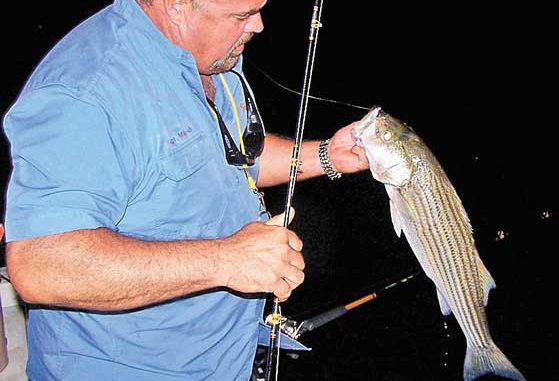
Striper action after dark can be exciting for the ‘enlightened.’
Standing barefoot in the cockpit of his center-console Ranger at quarter past midnight, with only a small, 12-volt light illuminating his boat, guide and pro striper fisherman Mike Lundy made a surprising statement.
“I fish all over the country for a lot of different species,” Lundy said, “but of all the tactics out there, this is absolutely the most fun!”
The grin on his face wasn’t visible, but the tone of his voice and the green, silhouetted outline of the bowed rod in his hands left no doubt that he wasn’t kidding.
A Statesville native, Lundy fishes on several king mackerel tournament circuits, teaches at many fishing schools and operates Pro-Motion Guide Service, guiding for striped bass on reservoirs across North Carolina.
He loves to fish so much that, slipping quietly across the surface of Lake Norman, you’ve got to believe him — even if his boat is trailing along what looks to be an inverted, underwater version of a Star Wars light saber.
The Night Stalker
Lundy’s tactics were common enough by striped bass standards. Just before dark, he spent 30 minutes collecting bait with a cast net near the concrete barrier that separates Lake Norman from the Duke Energy plant. The catch was mostly threadfin shad, with a few chunky gizzards and an occasional blueback herring mixed in.
Once the sun went down, he hooked up two planer boards on either side of the boat that ran 10 to 15 yards out to the side and behind the transom. Two free lines, one with a No. 5 split shot crimped a couple of feet above the bait, were also tossed out the back. Then he pulled out a Hydro Glow light — commonly used by anglers who anchor and fish at night — from a long black case. The difference was, Lundy was trolling.
The light looked like a corded version of Luke Skywalker’s trusty sidearm, only it was encased in a clear plastic tube that’s completely submersible and has a long cord that connects to a 12-volt battery. When connected, the light glows a bright, iridescent green color.
“I’ve made a couple of modifications” Lundy said, unsheathing the 4-foot light and unrolling a 20-foot cord, plus another 20-foot cord spliced to it. “I lengthened the cord so it will float further back behind the boat.”
Lundy had also added a couple of 2-foot sections of “pool noodle,” a foam swimming-pool float with a hollow core. “I run the line through the middle of the noodles to keep the cord from dragging underwater while I fish,” he said.
Like most nights on the lake, the first 30 minutes were slow, although trolling the light did seem to collect more baitfish in less time than waiting for them to come to an anchored boat that sports lights. Not long after all traces of the sun had completely disappeared, it became apparent that the glow of the green light was working its magic. Several dark, torpedo shapes streaked through the glow, leaving only baitfish scales in their wake.
The rod rigged with the split-shot, which had been strategically placed to ride below the light, dipped over and screamed until Lundy grabbed it and struck back at the fish.
“During the day, these fish will stay deep along the channel in the mid-lake areas,” said Lundy, “but at night, they move up in the water column and chase shad on the humps, long points and even out over deep water — if there’s shad present.”
As soon as he’d boated the first fish, an 8-pound striper that he said was a decent fish for Norman, one of the planer-board rods began protesting and required help. After a brief melee that resulted in another fish in the box, Lundy rounded a point and trolled slowly across the front of several boat docks, most of which had some form of lighting on them.
“Pulling bait away from boat docks is another trick if the bite out on the points gets slow,” he said, “and it works on just about any lake. I adjust my speed according to the bite. I have to maintain at least .4 to .5 mph to keep the boards out behind the boat, but the bait has no trouble keeping up with the light. Sometimes speeding up to 1.0 or 1.5 will even trigger strikes.”
Because he’s fishing at night, Lundy relies a great deal on his electronics to find structure where stripers are holding and to know his position on the lake. He runs a Lowrance LCX 113 HD — fishing’s version of a wide-screen television — on his console. He splits the screen so he can observe goings-on below the boat while navigating with state-of-the art digital mapping on the other side.
Tales From The Experts
Lundy’s night-trolling tactics may seem a bit unusual, but they pay off in fish. Some anglers prefer to use lights, while others contend that they prefer to hide under the cover of darkness.
Rodney Crisco, a tournament fisherman from Albemarle, also favors using the green light —but with a down-rod presentation on Badin, his home lake.
“In the area from the mouth of Gar Creek up to the train trestle that crosses the Yadkin River are some great night fishing spots.” Crisco said. “There’s a string of points that lead out into the water around the Uwharrie Point Golf Course — the water is about 25 to 30 feet deep right out to the edge of the channel — and that’s a great place to hang a Hydro Glow out and just drift around or bump with the trolling motor. Stagger live herring on a Carolina rig and watch the depthfinder ’til you locate roaming schools of fish. The good thing is, with the light, they’ll often come to you.”
On occasion, Crisco will also venture north from his home and catch the night bite at High Rock Lake.
“This same tactic works well in the Crane Creek area at High Rock,” Crisco said. “The mouths of Flat Swamp Creek and Abbotts Creek usually hold a lot of fish. Another good area to work is around the stump-covered points from Second Creek to Panther Point. There’s a lot of submerged islands over that way, and those are prime spots to get over the top of at night.”
The other side of the coin is fishing in the dark. Buddy Parks of Lewisville has been guiding on Piedmont reservoirs for years, and one of his favorite night spots is the tailrace area on Lake Hickory below Rhodhiss Dam.
“Up the river from the (Rt.) 321 bridge are two great spots just off the river channel,” Parks said. “There’s a rocky shoal on the right and a steep underwater wall on the left. Both of these places are ambush points where stripers will chase baitfish. The stripers get spooky in that clear water, so I anchor and cut-bait fish with just enough light to see what I’m doing.”
Live or cut bait is not the only game in town. Guide David Clubb of Mooresville said the same stretch at Hickory can be a fantastic place to cast artificials for big rockfish.
“The area above (Rt.) 321 stays cool all summer, and shad will run the banks and spawn several times while it’s hot. That’s a great place to wake a shallow diving Redfin or Bomber,” he said.
Clubb works the area like he’s targeting largemouth bass, keying on super-shallow flats and blowdowns for stripers that are lying in wait to ambush the shad.
“When it’s real quiet, you can hear the shad splashing along the bank in just inches of water,” he said. “Occasionally, you’ll hear a big splash like somebody threw a concrete block in the water; that’s a big striper in there cutting them down.”

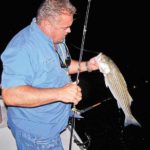
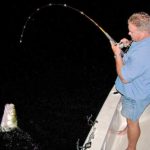
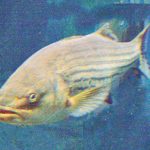
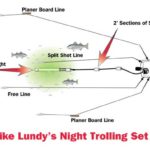



Be the first to comment